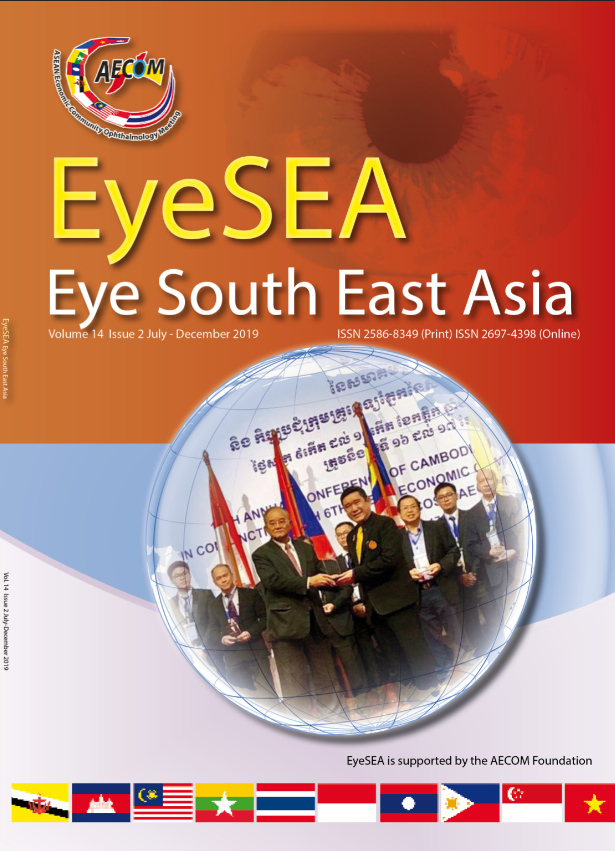Efficiency in Skill Development of Pterygium Excision with Amniotic Membrane Transplantation among the 1st Year Ophthalmology Residents
Main Article Content
Abstract
ABSTRACT
Purpose: To evaluate the learning curve of pterygium excision with amniotic membrane transplantation among the first year ophthalmology residents.
Methods: Prospective comparative study. Four first year ophthalmology residents were monitored for operating times and recurrence rates on all their cases of pterygium excision with amniotic membrane transplantation throughout one year. Data for baseline characteristics of patients with continuous data were analyzed for differences among residents using one-way ANOVA. Proportional data such as gender and recurrence rates, were analyzed for differences among residents using fisher’s exact test. Average predicted operating times with consecutive cases were analyzed using linear regression. Operating time stabilization with consecutive cases is visualized by a Locally Weighted Scatterplot Smoothing (LOWESS) and quadratic best fit lines.
Results: A total of 159 eyes (159 patients) with primary pterygium excision was performed with sutured amniotic membrane transplantation. All cases were attributed to four ophthalmology residents composed of 40, 41, 42 and 36 patients. The average operating time was 50.38 ± 13.92 minutes, with a range of 28 to 100 minutes. The operating time declined in proportion to the number of patients and stabilized after 38 cases, averaging 43.33 ± 18.93 minutes. The pterygium recurrence rate found in this study was 11.94%
Conclusions: Pterygium excision with sutured amniotic membrane transplantation is considered an appropriate training procedure for ophthalmology residency training due to the duration needed to reach the learning curve. Additionally, the rate of recurrence among residents is comparable to that of other similar studies.
Keywords: learning curve, operating time, pterygium excision, amniotic membrane transplantation, recurrent pterygium
Ethics: This study was approved for ethical research in human with the human research ethics committee of Thammasat university, Thailand (Research ID: MTU-EC-OP-0-105/56)
Article Details
References
1. Di Girolamo N, Chui J, Coroneo MT, et al. Pathogenesis of pterygia: role of cytokines, growth factors, ad matrix metalloproteinases. Prog Retin Eye Res. 2004;23:195–228.
2. Taylor HR, West SK, Rosenthal FS, et al. Corneal changes associated with chronic UV irradiation. Arch Ophthalmol. 1989;107:1481–1484.
3. Moran DJ, Hollows FC. Pterygium and ultraviolet radiation: a positive correlation. Br J Ophthalmol. 1984;68:343–346.
4. Coroneo MT, Di Girolamo N, Wakefield D. The pathogenesis of pterygia. Curr Opin Ophthalmol. 1999;10:282–288.
5. McCarty CA, Fu CL, Taylor HR (2000) Epidemiology of pterygium in Victoria, Australia. Br J Ophthalmol 84:289–292.
6. Gazzard G, Saw SM, Farook M, Koh D, Widjaja D, Chia SE et al (2002) Pterygium in Indonesia: prevalence, severity and risk factors. Br J Ophthalmol 86:1341–1346.
7. Wong TY, Foster PJ, Johnson GJ, Seah SK, Tan DT (2001) The prevalence and risk factors for pterygium in an adult Chinese population in Singapore: the Tanjong Pagar survey. Am J Ophthalmol 131:176–183.
8. Lewallen S. A randomized trial of conjunctival autografting for pterygium in the tropics. Ophthalmology 1989; 96: 1612–4.
9. Rosen R. Amniotic Membrane Grafts to Reduce Pterygium Recurrence. Cornea. 2018 Feb;37(2):189-193.
10. Tan DT, Chee SP, Dear KB, Lim AS (1997) Effect of pterygium morphology on pterygium recurrence in a controlled trial comparing conjunctival autografting with bare sclera excision. Arch Ophthalmol 115:1235–1240.
11. Hirst LW (2003) The treatment of pterygium. Surv Ophthalmol 48:145–180.
12. Ti SE, Tan DT (2003) Tectonic corneal lamellar grafting for severe scleral melting after pterygium surgery. Ophthalmology 110:1126–1136.
13. Tarr KH, Constable IJ (1980) Late complications of pterygium treatment. Br J Ophthalmol 64:496–505.
14. Kenyon KR, Wagoner MD, Hettinger ME (1985) Conjunctival autograft transplantation for advanced and recurrent pterygium. Ophthalmology 92:1461–1470.
15. Ma DH, See LC, Liau SB, Tsai RJ (2000) Amniotic membrane graft for primary pterygium: comparison with conjunctival autograft and topical mitomycin C treatment. Br J Ophthalmol 84:973–978.
16. Prabhasawat P, Barton K, Burkett G, Tseng SC (1997) Comparison of conjunctival autografts, amniotic membrane grafts, and primary closure for pterygium excision. Ophthalmology 104:974–985.
17. Luanratanakorn P, Ratanapakorn T, Suwan-Apichon O, Chuck RS (2006) Randomised controlled study of conjunctival autograft versus amniotic membrane graft in pterygium excision. Br J Ophthalmol 90:1476–1480.
18. Tananuvat N, Martin T (2004) The results of amniotic membrane transplantation for primary pterygium compared with conjunctival autograft. Cornea 23:458–463.
19. Koranyi G, Seregard S & Kopp ED (2004): Cut and paste: a no suture, small incision approach to pterygium surgery. Br J Ophthalmol 88: 911–914.
20. Koranyi G, Seregard S & Kopp ED (2005): The cut-and-paste method for primary pterygium surgery: long-term follow-up. Acta Ophthalmol Scand 83: 298–301.
21. Por YM & Tan DT (2010): Assessment of fibrin glue in pterygium surgery. Cornea 29: 1–4.
22. Gogate P, Deshpande M, Dharmadhikari S. Which is the best method to learn ophthalmology? Resident doctors’ perspective of ophthalmology training. Indian J Ophthalmol 2008;56:409 12.
23. Le K, Bursztyn L, Rootman D, Harissi Dagher M. National survey of Canadian ophthalmology residency education. Can J Ophthalmol 2016;51:219 25.
24. Ramsay CR, Grant AM, Wallace SA et al. (2001): Statistical assessment of the learning curves of health technologies. Health Technol Assess 5: 1–79.
25. Cook JA, Ramsay CR & Fayers P (2004): Statistical evaluation of learning curve effects in surgical trials. Clin Trials 1: 421–427.
26. Deusinger SS (1992): Analyzing errors in practice. A vehicle for assessing and enhancing the quality of care. Int J Technol Assess Health Care 8: 62–75.
27. Koranyi G, Artzen D, Wijk T. Learning curve in the Cut and Paste method for surgery of primary pterygium. Acta Ophthalmol. 2013: 91: 463–468.
28. Farrah JJ, Lee GA, Greenrod E et al. (2006): Outcomes of autoconjunctival grafting for primary pterygia when performed by consultant compared with trainee ophthalmologists. Clin Experiment Ophthalmol 34:857–860.
29. Kositphipat K, Tananuvat N, Choovuthayakorn J. Results of pterygium excision adjunct with conjunctival autograft transplantation for primary pterygium by ophthalmology trainees. Int Ophthalmol 2016: 36:615–621.
30. Chalioulias K, Dwarika D, Thakur S (2007) Pterygium excision with conjunctival autograft: consultant versus trainee. Clin Exp Ophthalmol 35:396.


